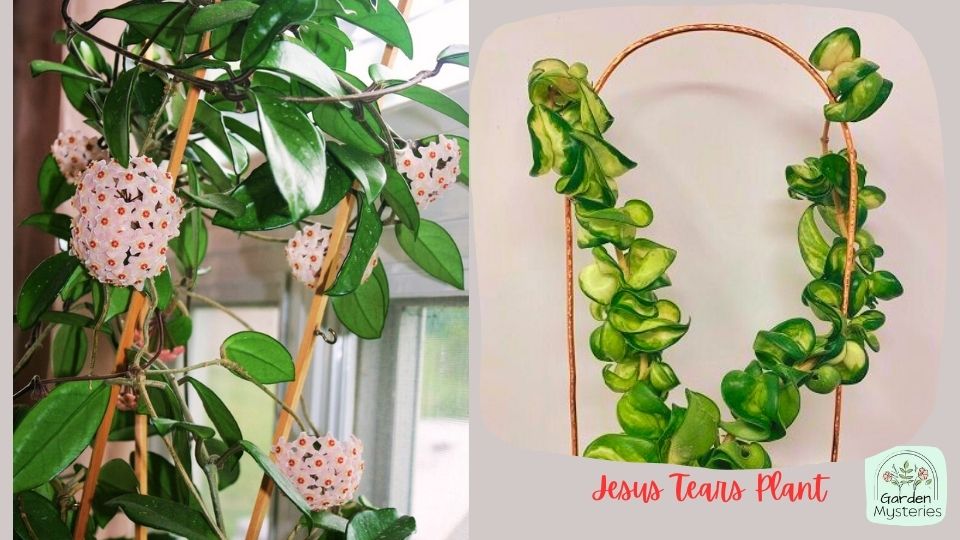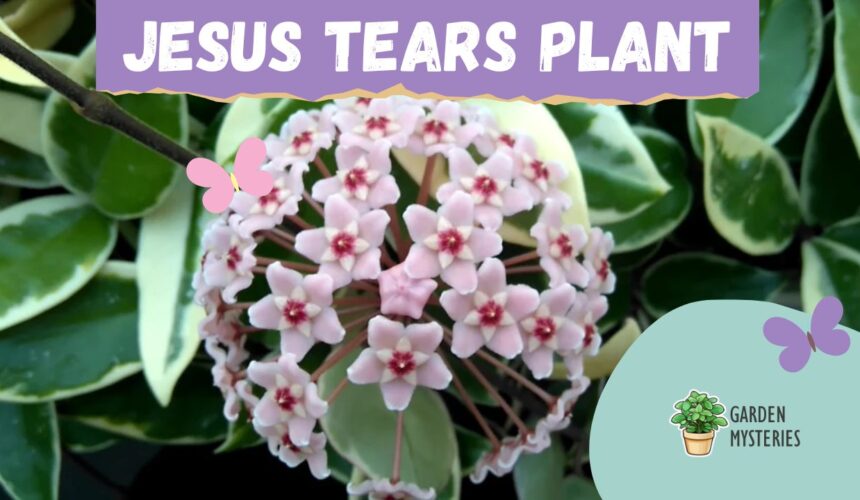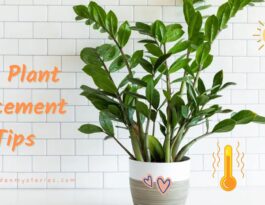Today, I want to introduce you to a graceful plant that goes by the name Jesus Tears plant. If you’re a beginner looking to add a touch of elegance to your indoor garden, this Jesus Tears plant could be your perfect match.
Let’s dig deep into Jesus Tears and explore all you need to know about caring for this enchanting succulent. So, keep your seat tight and read till the end.
What Is Jesus’ Tears Plant?
The plant commonly referred to as Jesus Tears plant is the Senecio herreianus, also known as the String of Tears. This captivating succulent hails from South Africa and showcases a delicate elegance with its bead-like leaves resembling teardrops.
Its translucent green leaves hang gracefully on slender trailing stems. Thus it creates a visually appealing cascading effect. To keep this plant thriving, provide bright, indirect sunlight and a well-draining succulent soil mix. Watering should be done when the top inch of soil is dry to the touch.
Regular pruning helps maintain its charm, while propagation can multiply its presence in your garden. Keep in mind that it’s mildly toxic if ingested, so you should place it out of reach from pets and children.
With its unique appearance and relatively simple care routine, the Jesus Tears plant can be a lovely addition to your indoor garden.
Is Hoya Carnosa and Jesus Tears Plant the Same?
Yes, Hoya carnosa and Jesus Tears plants are indeed the same. It’s like having two names for the same cool friend. Hoya carnosa is the scientific name for this plant, while Jesus Tears is one of its common names.
The plant got this unique nickname because of the droplets of nectar-like sap that sometimes form on its leaves, resembling tears.
Now, let’s talk about why it’s called Hoya carnosa. Hoya comes from the name of a botanist, Thomas Hoy, who specialized in this plant family. Carnosa refers to the fleshy nature of its leaves.
These plants are pretty cool. They have thick, waxy leaves that help them retain moisture. So, they are low-maintenance and perfect for indoor spaces.
Whether you call it Hoya carnosa or Jesus Tears, this plant adds a touch of greenery and intrigue to any room. Plus, it’s a conversation starter. Imagine telling your friends about the plant that’s also known as Jesus Tears.
Can I Grow Hoya Indoor?
You can successfully grow Hoya plants indoors. Hoya, also known as the Wax Plant, thrives in indoor environments. Their thick, waxy leaves help them tolerate lower light conditions.
Choose a well-draining potting mix and a container with drainage holes for growing a hoya plant indoors.
You should place your Hoya in bright, indirect light near a window, but avoid direct sunlight, which can scorch its leaves. Maintain indoor temperatures between 60-80°F (15-27°C).
Water your Hoya or Wax plants moderately. You should let the top inch of soil dry between waterings. Over-watering can lead to root rot. During the growing season (spring and summer), fertilize every 4-6 weeks with a balanced liquid fertilizer.
Hoya plants are known for their trailing vines and can be encouraged to climb or cascade using supports. Regular pruning can help maintain their shape.
With proper care for hoya plant indoors, your Hoya will reward you with its unique foliage and occasional clusters of star-shaped, fragrant flowers. Also, you can keep crown of thorns alongside hoya plants.

Are you looking for alternative options for Earthbox replant kit? Here is the solution for you.
How to Take Care for Hoya Plants?
Care for Hoya plants, also known as Wax Plants or Hindu Rope Plants, can be a rewarding journey filled with lush foliage and occasional fragrant flowers. Here’s an elaborate guide to help you provide the best care for your Hoya:
Step 1: Light
You should place your Hoya in bright, indirect light. While they can tolerate lower light conditions, insufficient light may slow down growth and reduce flowering. You should avoid direct sunlight, as it can scorch the leaves.
Step 2: Temperature
Hoyas prefer average room temperatures between 60-80°F (15-27°C). Protect them from sudden temperature fluctuations and drafts, as these can stress the plant.
Step 3: Soil
Choose a well-draining potting mix. A mix formulated for succulents or cacti works well. Make sure your pot has drainage holes to prevent waterlogging.
Step 4: Watering
You should accept the top inch of the soil to dry before watering. Water thoroughly and let the excess water drain away.
During the growing season (spring and summer), water more frequently, but reduce watering in the cooler months. Over-watering can lead to root rot, so be cautious.
Step 5: Humidity
Hoyas appreciate slightly higher humidity, but they can adapt to average indoor levels. You can occasionally mist the leaves or place a tray of water near the plant to increase humidity.
Step 6: Fertilizing
You must feed your Hoya during the growing season (spring and summer) with a balanced liquid fertilizer every 4-6 weeks. Dilute the fertilizer to half-strength to avoid overfeeding.
Step 7: Pruning
Prune your Hoya to shape it and remove any leggy or unhealthy growth. This encourages bushier growth and maintains its appearance. You can also propagate hoya from the cuttings you prune.
Step 8: Trellising and Support
Hoyas are natural climbers. Provide a trellis, stake, or support for them to climb on. You can gently train the vines to follow the support structure.
Step 9: Repotting
Hoyas prefer slightly root-bound conditions, so you don’t need to repot frequently. Repot every 2-3 years or when you notice the plant outgrowing its container. Spring is the best time for repotting.
Step 10: Flowering
Hoyas are known for their clusters of star-shaped flowers that release a sweet fragrance, especially at night. Flowers form on mature plants and can take some time to appear. Adequate light and proper care encourage flowering.
Step 11: Pests and Diseases
You should keep an eye out for common houseplant pests like aphids and mealybugs. If you spot any, treat them promptly with insecticidal soap.

Tips to Grow Jesus Tears Plant at Home?
Here are some quick tips to help you grow a Jesus Tears plant (Senecio herreianus) successfully at home:
- Choose a well-draining succulent soil mix.
- Place in bright, indirect sunlight.
- Water when the top inch of soil is dry.
- Avoid overwatering to prevent root rot.
- Maintain room temperatures of 65-75°F (18-24°C).
- Fertilize with diluted balanced liquid fertilizer in the growing season.
- Gently prune for a neat appearance and remove wilted parts.
- Propagate by snipping healthy stems, letting them dry, and planting in well-draining soil.
- Consider hanging or cascading placement to showcase its charm.
- Keep away from pets and children because of mild toxicity.
FAQs
Can I grow Jesus Tears from cuttings?
Yes, you can propagate Jesus Tears by snipping healthy stems, letting them dry for a day or two, and then planting them in well-draining soil. Keep the soil lightly moist until new growth appears.
Is the Jesus Tears plant toxic to pets?
Yes, the Jesus Tears plant is mildly toxic to pets if ingested. Keep it out of reach of cats, dogs, and other curious animals to ensure their safety.
Can I hang my Jesus Tears plant or place it on a shelf?
Jesus Tears cascading growth habit makes it perfect for hanging planters or shelves where its teardrop leaves can elegantly dangle, adding a touch of charm to your space.
How do I prevent my Jesus Tears plant from becoming leggy?
Pruning is the key to preventing legginess. Trim back long, trailing stems to encourage bushier growth. This also helps maintain the plant’s neat appearance and prevents it from becoming too unruly.
If you are trying to make soil mix for Pothos cutting at home, you can take a look.





